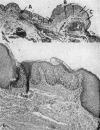Head and neck cancer: an evolving treatment paradigm
- PMID: 18798532
- PMCID: PMC2751600
- DOI: 10.1002/cncr.23654
Head and neck cancer: an evolving treatment paradigm
Abstract
Since the inception of this journal in 1948, the understanding of etiologic factors that contribute to and the treatment of head and neck cancer has evolved dramatically. Advances in surgery, radiation therapy, and chemotherapy have improved locoregional control, survival, and quality of life. The outcomes of these treatment modalities have shifted the focus of curative efforts from radical ablation to preservation and restoration of function. This evolution has been documented in the pages of Cancer for the past 6 decades. This review focuses on the evolution of treatment approaches for head and neck cancer and future directions while recognizing the historic contributions recorded within this journal.
Figures




References
-
- Parkin DM, Bray F, Ferlay J, Pisani P. Global cancer statistics, 2002. CA Cancer J Clin. 2005;55:74–108. - PubMed
-
- Jemal A, Siegel R, Ward E, Murray T, Xu J, Thun MJ. Cancer statistics. CA Cancer J Clin. 2007;57:43–66. - PubMed
-
- Ries LAG, Melbert D, Krapcho M, et al. E. SEER Cancer Statistics Review, 1975–2004. National Cancer Institute; [Accessed on August 12, 2008]. Available from: http://seer.cancer.gov/csr/1975_2004/
-
- Shiboski CH, Schmidt BL, Jordan RC. Tongue and tonsil carcinoma: increasing trends in the US population ages 20–44 years. Cancer. 2005;103:1843–1849. - PubMed
-
- Levin M. Some epidemiological features of cancer. Cancer. 1948;1:489–497. - PubMed
Publication types
MeSH terms
Grants and funding
LinkOut - more resources
Full Text Sources
Other Literature Sources
Medical
Molecular Biology Databases
Miscellaneous

